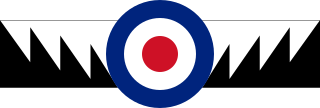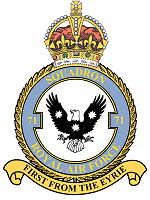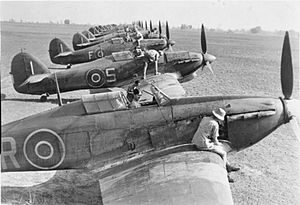
No. 206 Squadron is a Test and Evaluation Squadron of the Royal Air Force. Until 2005 it was employed in the maritime patrol role with the Nimrod MR.2 at RAF Kinloss, Moray. It was announced in December 2004 that 206 Squadron would disband on 1 April 2005, with half of its crews being redistributed to Nos. 120 and 201 Squadrons, also stationed at Kinloss. This was a part of the UK Defence Review called Delivering Security in a Changing World; the Nimrod MR.2 fleet was reduced in number from 21 to 16 as a consequence.

No. 610 Squadron of the Royal Air Force was a Squadron of the Auxiliary Air Force. Comprising very high quality pilots, often ex-RAF officers and occasionally locally based company Test pilots from companies such as de Havilland and Airwork. Its pilots were initially part timers who would spend their weekends and spare time flying and practising combat manoeuvres. The squadron was named the "County of Chester" and adopted the motto "Alifero tollitur axe ceres"; which translates as "Ceres rising in a winged chariot". Ceres being the Roman Goddess of Wheat, a reference to Chester's Agricultural sector. Its badge contained the image of a garb.

488 Squadron was the name given to two distinct Royal New Zealand Air Force squadrons during the Second World War. Both were formed under Article XV of the Empire Air Training Scheme and served under the operational command of the Royal Air Force.
No. 679 Squadron RAF was an anti-aircraft co-operation squadron of the Royal Air Force during the Second World War.
No. 667 Squadron RAF was an anti-aircraft co-operation squadron of the Royal Air Force during the Second World War.

No. 257 Squadron RAF was a flying squadron of the Royal Air Force active during the First World War, the Second World War and also the Cold War. It was finally disbanded in December 1963.

No. 607 Squadron is an auxiliary squadron of the Royal Air Force. It was formed in 1930 as a bomber unit in the Auxiliary Air Force and changed in 1936 to the fighter role. It fought in that role during the Second World War in Europe and Asia. After the war, in 1946, the squadron reformed as a fighter unit. Awarded the title Royal Auxiliary Air Force by King George in 1947, 607 Sqn was disbanded with all the other flying units of the RAuxAF on 10 March 1957. It reformed on 5 January 2015, as a General Service Support Squadron (GSS).
No. 650 Squadron RAF was an anti aircraft co-operation squadron of the Royal Air Force during the Second World War.

No. 358 Squadron RAF was a Bomber and Special duties squadron of the Royal Air Force flying with South East Asia Command from 1944 to 1945.
No. 681 Squadron RAF was a photo-reconnaissance squadron of the Royal Air Force during the Second World War.

No. 71 Squadron was a Royal Air Force aircraft squadron. The number has been used three times: once by the Royal Flying Corps for an Australian Flying Corps squadron; in the Second World War as the first of three Eagle Squadrons; and post-war as a fighter-bomber unit under the command of Royal Air Force Germany.
No. 113 Squadron began service in 1917 with the Egyptian Expeditionary Force commanded by General Edmund Allenby. Initially, the squadron was a unit of the Royal Flying Corps, serving during the Sinai and Palestine Campaign and as a reconnaissance, army cooperation, bomber, fighter, transport and missile operation squadron during its existence.
No. 261 Squadron RAF was a squadron of the Royal Air Force during World War I and World War II. It was involved in the defence of Malta from August 1940 till May 1941 and the campaign in Burma.
No. 520 Squadron RAF was a meteorological squadron of the Royal Air Force during the Second World War.
Number 76 Squadron was a squadron of the Royal Air Force. It was formed during World War I as a home defence fighter squadron and in its second incarnation during World War II flew as a bomber squadron, first as an operational training unit and later as an active bomber squadron. With the end of the war the squadron converted to the role of transport squadron, to be reactivated shortly in the bomber role during the 1950s. From 2007 to 2011, it was a training unit, equipped with the Short Tucano at RAF Linton-on-Ouse.
No. 136 Squadron RAF was a short-lived RAF unit that saw no action in World War I, but upon reformation became the highest scoring unit in South East Asia Command during World War II. Shortly after the war the squadron was disbanded.
No. 527 Squadron RAF was a radar calibration unit of the Royal Air Force between 1943 and 1958.
No. 531 Squadron RAF was one of the ten Turbinlite nightfighter squadrons of the Royal Air Force during the Second World War.
No. 567 Squadron was an anti-aircraft co-operation squadron of the Royal Air Force, formed during World War II and active between December 1943 and June 1946 in the defence of south-east England.
No. 240 Squadron RAF was a Royal Air Force flying boat and seaplane squadron during World War I, World War II and up to 1959. It was then reformed as a strategic missile squadron, serving thus till 1963.










